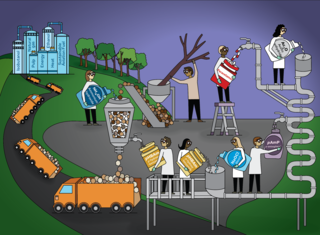Efficient production of p-hydroxybenzamide from poplar biomass

Objective
To explore a strategy for extracting p-hydroxybenzoate from biomass feedstocks (e.g., poplar and palm trees) and converting it into a portfolio of commodity chemicals including p-hydroxybenzamide, p-aminophenol, and paracetamol.
Approach
Explored the impact of aqueous ammonia treatment conditions on the ratio of p-hydroxybenzoic acid to p-hydroxybenzamide in the aqueous waste stream.
Results
The targeted product in the first processing stage is p-hydroxybenzamide produced from p-hydroxybenzoate esters found in the plant. A continuous reaction converts the p-hydroxybenzamide to p-aminophenol and recovers unreacted p-hydroxybenzamide. The p-aminophenol can then be acetylated to form paracetamol, which is isolated by liquid/liquid extraction at >95% purity and an overall p-hydroxybenzamide-to-paracetamol process yield of ~90%. The newly patented process uses water as the solvent, no chromatography, inexpensive reagents, no protecting groups, and scalable technology.
Impact
p-aminophenol has an estimated global market worth $1.4 billion. Paracetamol is one of the most abundantly produced pharmaceuticals in the world, valued at $130 million. Modifications of this process have the potential to produce an array of chemical building blocks for the manufacturing materials and chemical products like plastics, surfactants, pigments, and pharmaceuticals.